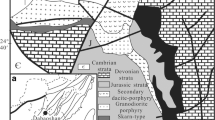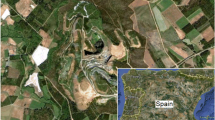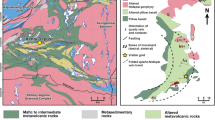Abstract
Nanogold exists widespread in the environment. For example, countless nanogold particles appear in weathered rocks due to chemical decomposition of mineral-concentrators (e.g., pyrite, arsenopyrite, pyrrhotite, and magnetite). Nanogold is usually represented by isolated particles dispersed in minerals and sedimentary rocks, but in certain conditions, Au nanoparticles are able to merge with each other and compose simple or complex aggregates. The mechanisms of aggregation are related to specific geochemical situations in the environment. In addition, superfluous surface energy of metal nanoparticles and their chemical activity essentially contribute to aggregation. There are two main ways of accumulation, namely adsorption on surface of minerals (mainly placer Au grains) and gradual consolidation of separate Au nanoparticles due to natural amalgamation. Aggregation of Au nanoparticles is a natural mechanism of accumulation in sedimentary rocks, which may be reproduced in nanotechnologies.









Similar content being viewed by others
References
Casey, W. H. (2001). A view of reactions at mineral surfaces from the aqueous phase. Mineral Magazine, 65(3), 323–337.
Cook, N. J., & Chryssoulis, S. L. (1990). Concentrations of “invisible gold” in the common sulfides. Canadian Mineralogist, 28, 1–16.
Daniel, M. C., & Astruc, D. (2004). Gold nanoparticles: assembly, supermolecular chemistry, quantum-size-related properties, and applications toward biology, catalysis, and nanotechnology. Chemistry Review, 104, 293–346.
Egorova, E. M. (2006). Metal nanoparticles: Their properties and role in living organisms. Ethics and Science of Future, pp. 219–224. (in Russian).
Freise, F. W. (1931). The transportation of gold by organic underground solutions. Economic Geology, 26, 412–431.
Hough, R. M., Noble, R. R. P., Hitchen, G. J., Hart, R. D., Reddy, S. M., Saunders, M., et al. (2008). Naturally occurring gold nanoparticles and nanoplates. Geology, 36(7), 571–574.
Jablokova, S. V. (1965). Origin of “new” gold in some placers of the South Yakutia. Placer Geology, pp. 152–155. (in Russian).
Kalinin, J. A., Zhmodik, S. M., & Spiridonov, A. M. (2010). Spherical gold of laterite weathering crust. In Placers and weathering crust deposits: modern problems of investigation and utilization (pp. 290–294). Novosibirsk: Geology and Mineralogy Institute. (in Russian).
Lengke, M., & Southam, G. (2006). Bioaccumulation of gold by sulfate-reducing bacteria cultured in the presence of gold(I)-thiosulfate complex. Geochimica et Cosmochimica Acta, 70, 3646–3661.
Mann, A. W. (1984). Mobility of gold and silver in laterite weathering profiles: Some observations from Western Australia. Economic Geology, 79, 38–50.
Mikhlin, Y., Romanchenko, A., & Asanov, J. (2006). Oxidation of arsenopyrite and deposition of gold on the oxidized surfaces: A scanning probe microscopy, tunneling spectroscopy, and XPS study. Geochimica et Cosmochimica Acta, 70, 4874–4888.
Navrotsky, A. (1994). Physics and chemistry of earth materials (p. 417). Cambridge, MA: Cambridge University Press.
Nikolaeva, L. A. (1958). “New” gold in placers of Lena Region. Works of TSNIGRI, 25(2), 19–122. (in Russian).
Novgorodova, M. I. (2005). Methacolloid gold. New data on minerals, 40, 106–114. (in Russian).
Osovetsky, B. M. (2012). Nanosculpture of gold surface (p. 232). Perm: Perm State University Press. (in Russian).
Osovetsky, B. M. (2013). Natural nanogold (p. 176). Perm: Perm State University Press. (in Russian).
Palenik, C. S., Utsunomiya, S., Reich, M., Kesler, S. E., & Wang, L. (2004). “Invisible” gold revealed: Direct imaging of gold nanoparticles in a Carlin-type deposit. American Mineralogist, 83, 1359–1366.
Pankratov, C., & Panov, V. (1986). Surfaces of solids. Science and Life, 5–6, 34–65. (in Russian).
Petrovskaya, N. V. (1973). Native gold (p. 253). Moscow, Nauka. (in Russian).
Reich, M., Kesler, S. E., Utsunomiya, S., Palenik, C. S., Chryssoulis, S. L., & Ewing, R. C. (2005). Solubility of gold in arsenian pyrite. Geochimica et Cosmochimica Acta, 69(11), 2781–2796.
Reith, F., Lengke, M. F., Falconer, D., Craw, D., & Southam, G. (2007). The geomicrobiology of gold. International Society of Microbiological Ecology Journal, 1, 567–584.
Schoomen, M. A. A., Fisher, N. S., & Wente, M. (1992). Gold sorption onto pyrite and geothite: A radiotracer study. Geochimica et Cosmochimica Acta, 56, 1801–1814.
Schweigart, H. (1965). Solid solution of gold in sulfides. Economic Geology, 6(7), 1540–1541.
Shadrina, S. V. (2005). Free gold from hypergene zone of the Suzdal deposit, North Kazakhstan. In Placers and weathered rock deposits: facts, problems, decisions. XIII International Symposium on Geology of Placers and Weathered Rock Deposits (pp. 313–315). Perm, Russia.
Simon, G., Kesler, S. E., & Chryssoulis, S. (1999). Geochemistry and textures of gold-bearing arsenian pyrite, Twin Creeks, Nevada: Implications for deposition of gold in Carlin-Type deposits. Economic Geology, 89, 405–422.
Slowey, A. J. (2010). Rate of formation and dissolution of mercury sulfide nanoparticles: The dual role of natural organic matter. Geochimica et Cosmochimica Acta, 74, 4693–4708.
Widler, A. M., & Seward, T. M. (2002). The adsorption of gold(I)-hydrosulphide by iron sulfide surfaces. Geochimica et Cosmochimica Acta, 66(3), 383–402.
Zhmodik, S. M., Kalinin, Y. A., Roslyakov, N. A., Mironov, A. G., Mikhlin, Y., Belyanin, D. K., et al. (2012). Nanoparticles of noble metals in the supergene zone. Geology of Ore Deposits, 54(2), 141–154.
Acknowledgments
The author wants to acknowledge some people who provided the grains of gold for the study (AG Barannikov, JA Kisin, VA Naumov, AJ Konopatkin) and colleagues from the Department of Mineralogy and Petrography of Perm State University for participating in field expeditions and extracting gold grains under laboratory conditions.
Author information
Authors and Affiliations
Corresponding author
Rights and permissions
About this article
Cite this article
Osovetsky, B.M. Aggregation of Nanogold Particles in the Environment. Nat Resour Res 25, 241–253 (2016). https://doi.org/10.1007/s11053-015-9277-9
Received:
Accepted:
Published:
Issue Date:
DOI: https://doi.org/10.1007/s11053-015-9277-9




